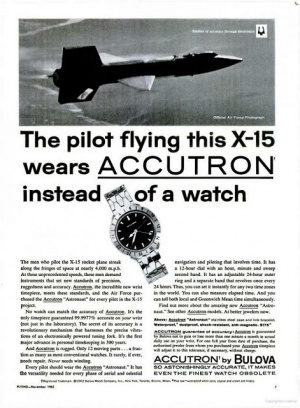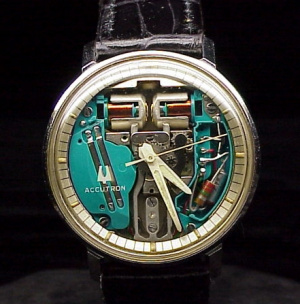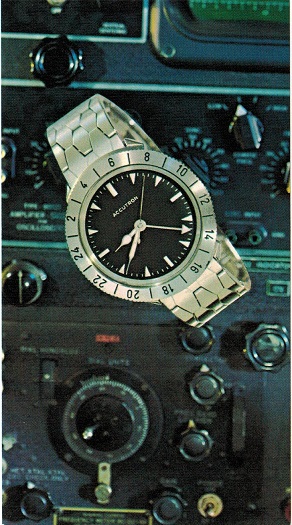Bulova Accutron Astronaut: Difference between revisions
| Line 10: | Line 10: | ||
Bulova also lent its expertise to the U.S. government during the late-1960s Space Race with the Soviet Union. During its decades-long partnership with the National Aeronautics and Space Administration (NASA), Bulova helped outfit numerous satellite missions with Accutron timekeeping technology, starting with the Vanguard 1 in 1958. All timekeeping instruments, including instrument-panel clocks, aboard NASA’s manned spacecraft missions leading up to and including the legendary first Moon Walk on July 21, 1969, were equipped with Bulova Accutron tuning fork technology. (At the time, even NASA scientists could not know how a mechanical timekeeper would function in low-gravity conditions.) Of course, watch history buffs are well aware that it was the [[Omega Speedmaster|Omega Speedmaster Professional]] (now appropriately nicknamed the Moonwatch) that won the right to be official NASA watch and hence the first watch worn on the moon during the historic Apollo 11 mission in 1969. Fewer may realize that astronaut Buzz Aldrin also placed a Bulova Accutron timer in the Sea of Tranquility to help transmit critical data transmissions. | Bulova also lent its expertise to the U.S. government during the late-1960s Space Race with the Soviet Union. During its decades-long partnership with the National Aeronautics and Space Administration (NASA), Bulova helped outfit numerous satellite missions with Accutron timekeeping technology, starting with the Vanguard 1 in 1958. All timekeeping instruments, including instrument-panel clocks, aboard NASA’s manned spacecraft missions leading up to and including the legendary first Moon Walk on July 21, 1969, were equipped with Bulova Accutron tuning fork technology. (At the time, even NASA scientists could not know how a mechanical timekeeper would function in low-gravity conditions.) Of course, watch history buffs are well aware that it was the [[Omega Speedmaster|Omega Speedmaster Professional]] (now appropriately nicknamed the Moonwatch) that won the right to be official NASA watch and hence the first watch worn on the moon during the historic Apollo 11 mission in 1969. Fewer may realize that astronaut Buzz Aldrin also placed a Bulova Accutron timer in the Sea of Tranquility to help transmit critical data transmissions. | ||
===Genesis | ===Genesis 1962 - The Astronaut=== | ||
[[File:Accutron 1962.jpg|thumb|1962 Accutron]] | |||
Bulova produced the Astronaut, a 214-based GMT timepiece with a 24-hour rotating bezel, secondary 24-hour hand and hack function. The Astronaut was initially developed by Bulova for the US space program, but ultimately found its greatest success in the consumer market. The Astronaut is the only timepiece to use the 214HN sub-caliber, widely considered to be the ultimate Accutron movement. | Bulova produced the Astronaut, a 214-based GMT timepiece with a 24-hour rotating bezel, secondary 24-hour hand and hack function. The Astronaut was initially developed by Bulova for the US space program, but ultimately found its greatest success in the consumer market. The Astronaut is the only timepiece to use the 214HN sub-caliber, widely considered to be the ultimate Accutron movement. | ||
Revision as of 14:59, 11 June 2020
Bulova Accutron Astronaut

When the first Accutron tuning fork watches were released to the public in 1960 they were seen as nothing short of revolutionary. The Astronaut was (and still is) the ultimate expression of this extraordinary period in watch technology. The smooth sweep of the second hand, the soothing hum of the motor, the hidden crown, the flying saucer appearance all loudly proclaimed 'THE FUTURE IS HERE'. It was science-fiction brought to life for a cold-war generation.
The background - A SpaceView

The Bulova Accutron was the world’s first fully electronic watch. Rolled out under worldwide scrutiny at the World’s Watchmaking Fair in Basel, Switzerland (now called Baselworld) in 1960, the watch incorporated a revolutionary new technology that utilized a 360-Herz tuning fork, powered by a one-transistor electronic oscillator, to drive the timekeeping functions rather than a traditional balance wheel. The brainchild of Bulova engineer (and Basel native) Max Hetzel, this technology ensured an oscillation rate of 360 times per second — nearly 150 times faster than that of a mechanical, balance-wheel-driven timepiece — and guaranteed an accuracy to just one minute per month. The Accutron was distinguished by its telltale humming instead of ticking, a sound generated by the vibrating tuning fork.
The first Accutron model, called Spaceview 214 and featuring its now-famous open dial showing off the high-tech movement, also deviated from traditional wristwatch design with its lack of setting stem and crown on the side of the watch; these elements were instead placed on the back of the case. The Accutron has been the cornerstone of Bulova’s portfolio ever since.
The Moon Connection
Bulova also lent its expertise to the U.S. government during the late-1960s Space Race with the Soviet Union. During its decades-long partnership with the National Aeronautics and Space Administration (NASA), Bulova helped outfit numerous satellite missions with Accutron timekeeping technology, starting with the Vanguard 1 in 1958. All timekeeping instruments, including instrument-panel clocks, aboard NASA’s manned spacecraft missions leading up to and including the legendary first Moon Walk on July 21, 1969, were equipped with Bulova Accutron tuning fork technology. (At the time, even NASA scientists could not know how a mechanical timekeeper would function in low-gravity conditions.) Of course, watch history buffs are well aware that it was the Omega Speedmaster Professional (now appropriately nicknamed the Moonwatch) that won the right to be official NASA watch and hence the first watch worn on the moon during the historic Apollo 11 mission in 1969. Fewer may realize that astronaut Buzz Aldrin also placed a Bulova Accutron timer in the Sea of Tranquility to help transmit critical data transmissions.
Genesis 1962 - The Astronaut

Bulova produced the Astronaut, a 214-based GMT timepiece with a 24-hour rotating bezel, secondary 24-hour hand and hack function. The Astronaut was initially developed by Bulova for the US space program, but ultimately found its greatest success in the consumer market. The Astronaut is the only timepiece to use the 214HN sub-caliber, widely considered to be the ultimate Accutron movement.
Credits - https://www.watchtime.com/featured/the-history-of-bulova-through-10-milestone-bulova-watches/
